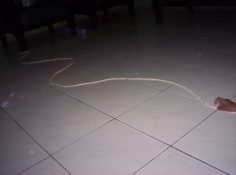Based on the propagation medium, the waves are grouped into two, namely mechanical waves and electromagnetic waves. Mechanical wave is a wave that requires a medium in the propagation. Among other examples of mechanical waves: sound waves, surface waves, and the waves on a string. Electromagnetic waves are waves that do not require the propagation medium. Example: light, radio waves, TV waves, X - rays, and gamma rays.
The wave is due to the merambat.Menurut perturbed physics concept, reflection wave propagation is perturbed, while the medium remains. Thus, a wave propagation without energy transfer followed by removal of the mass media.
A. Definition of Wave Mechanics
Mechanical wave is a wave that requires a medium in propagation.
Examples of mechanical waves:
- The waves that occur on the string if one end digerak move.
- The waves that occur on the surface of the water if given perturbed him (eg by dropping rocks on the surface of a quiet pond water).
B. Transverse waves
Transverse waves are waves that knock the direction perpendicular to the vibration direction (harassment).
Examples of transverse waves:
- Vibration learned gitas ray
- Vibrations shake the rope at one end
C. Longitudinal Waves
Longitudinal waves are waves that knock the direction parallel to the direction of vibration (direction of harassment)
Examples of longitudinal waves:
- Wave slinki tied at both ends to the stative then given perturbed at one end
- Sound waves in air
Wavelength
One wave length equal to the distance traveled in one period.
1) The wavelength of the transverse wave
In transverse waves, the wave consists of 3 vertices and 2 stomach. The distance between two nodes or two successive stomach is called a half or ½ wavelength λ (lambda),
2) The wavelength of the longitudinal wave
In the longitudinal wave, 1 wave consists of 1 density and 1 strain
The distance traveled by the wave in one second is called the wave propagation speed. Wave propagation speed is denoted by v and the unit m / s . The relationship between v, f, λ, and T are as follows:
Description:
λ = wavelength, units meters (m)
v = velocity of wave propagation, units meters / second
T = wave period, units of seconds or seconds (s)
f = frequency of the wave, or 1/second 1/second unit
Example Problem:
1. Waves generated in 1 second as shown below:
![soal1_thumb[1] soal1_thumb[1]](http://arifkristanta.files.wordpress.com/2009/07/soal1_thumb1.jpg?w=468)
a. what is the frequency of the wave?
b. When the distance PQ = 2 cm, then what is?
Completion:
According to the images, which occur as the wave 2 wave. Means, f = 2 wave / second or f = 2 Hz.
In figure 2 wave occurs (2λ). So 2 λ = 2 cm, or λ = 1 cm.
2. A rope stretched 8 m in length and vibrated. During the 2 second wave occurred as shown below! Define λ, f, T, and v.
![soal2_thumb[2] soal2_thumb[2]](http://arifkristanta.files.wordpress.com/2009/07/soal2_thumb21.jpg?w=468)
Completion:
from the picture, wave of as many as 4 λ.
Means: 4λ = 8 m so λ = 8/4 = 2 m
During the 2 second occurred four λ or for 1 second occurred 2λ
Thus, f = 2 wave / second or f = 2 Hz
T = 1 / f = ½ second so that v = λ f = 2 m x 2 Hz = 4 m/s




oke rahmi, is there the equation for transversal waves so we can calculate the frequency of transversal longitudinal?
BalasHapusmiss Rahmi,
BalasHapuswhether each wave has a propagation speed stable?
thanks